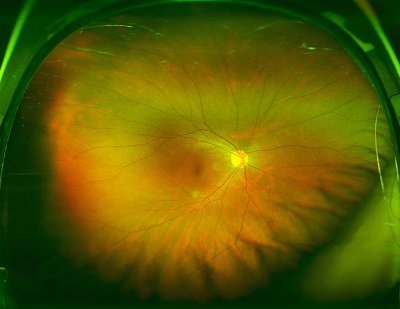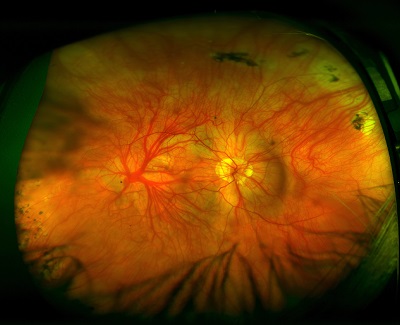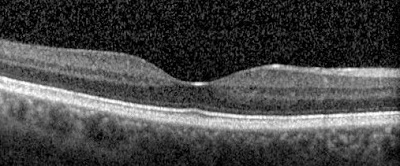Albinism and Low Vision
What Is Albinism?
Albinism represents a group of conditions characterized by a defect in the production of the pigment melanin, normally found in skin, eyes, and hair.
Any one of many genes responsible for melanin production can lead to albinism. There are two major types of albinism:
Oculocutaneous Albinism
- It is inherited in an autosomal recessive fashion. This means that both copies of the gene must be abnormal (one inherited from each parent) to manifest the disease.
- Only one abnormal gene results in “gene carrier” status, meaning the individual does not manifest the disease.
- In oculocutaneous albinism, there is little to no pigmentation/coloring of the skin, hair, and eyes.
Ocular Albinism
- It is inherited in an “X-linked” fashion.
- Females carry two X chromosomes, while males carry one X chromosome and one Y chromosome.
- Therefore, this disease primarily affects men, who need only one X chromosome with the albinism gene to manifest the disease. Females with the albinism gene on one of their two X chromosomes may be “gene carriers” of the condition.
- Unlike oculocutaneous albinism, which affects the skin, hair, and eyes, ocular albinism primarily affects the eyes. The skin and hair may be only slightly less pigmented than unaffected siblings.
How Does Albinism Affect the Eyes?
Albinism can affect the eyes in multiple ways, and individuals with albinism can vary significantly in how much their eyes and vision are affected:
- People who have albinism have little to no pigmentation of the iris. They also lack pigment in the “retinal pigment epithelial” cells between the retina and the choroid. This gives the retina a unique appearance and makes the choroid’s underlying blood vessels more visible.

A normal retina with no signs of albinism.
Source: Courtesy Mrinali Patel Gupta, M.D.,
Weill Cornell Medical College, New York

A retina displaying signs of albinism. The lack of pigmentation makes the
vessels of the choroid more visible and the retinal vessels have an abnormal course.
Source: Courtesy Mrinali Patel Gupta, M.D.,Weill Cornell Medical College, New York
- Since pigment in the eye absorbs light and helps us tolerate most kinds of bright light, the lack of pigment in these structures makes individuals with albinism very sensitive to light, called photosensitivity.
- People with albinism also have an underdeveloped fovea. The fovea is the part of the retina responsible for much of visual acuity. This is usually the abnormality that most affect vision in ocular albinism and oculocutaneous albinism. Depending on the degree of foveal underdevelopment, vision may be mildly or severely impaired. The following photos were taken using optical coherence tomography (OCT), which is a type of medical imaging technology that produces high-resolution cross-sectional and three-dimensional images of the retina and its supporting layers:

Optical coherence tomography (OCT) of a patient with albinism
shows an absence of a normal foveal contour. Source: Courtesy
Mrinali Patel Gupta, M.D., Weill Cornell Medical College, New York

In comparison, the normal foveal contour exhibits a dip as shown above.
The foveal contour and integrity are important for high acuity vision. Source:
Courtesy Mrinali Patel Gupta, M.D., Weill Cornell Medical College, New York
- In addition, people with albinism may have misrouting of the visual pathways connecting the eye to the part of the brain responsible for vision. “Misrouting” means nerve signals from the retina to the brain do not follow the usual eye-to-brain pathway.
- These abnormalities decrease best-corrected visual acuity from 20/40 to 20/200. Albinism is non-progressive and visual acuity may improve somewhat until the mid-teens, after which it remains fairly stable unless additional eye conditions develop.
- Infants with albinism also frequently exhibit abnormal, involuntary, rapid side-to-side or up-and-down movements of the eyes called nystagmus, as well as abnormalities in the alignment of the eyes called strabismus. The nystagmus often improves over time and, in some cases, may even disappear.
- Both nystagmus and strabismus can impede vision. In addition, nystagmus and strabismus can cause the individual with albinism to hold or tilt his or her head in an unusual way to see objects or surroundings as clearly as possible.
- Infants with albinism will often have a refractive error, which causes near-sightedness, far-sightedness, and/or astigmatism.
- Female carriers for the ocular albinism gene (i.e., females in whom only one of their two X chromosomes carry the disease-causing gene) may exhibit abnormal retinal pigmentation and mildly decreased iris pigmentation. Rarely, female carriers can be affected more severely and exhibit some of the findings described previously.
Is Albinism Associated with Other Medical Conditions?
There are two forms of oculocutaneous (autosomal recessive) albinism (see above) that are associated with systemic medical disease:
Chediak-Higashi Syndrome:
- In addition to albinism, individuals with this syndrome exhibit abnormalities in white blood cells of the immune system and are predisposed to infections. They may also have peripheral neuropathy, an abnormality in the peripheral nerves that may cause decreased sensation or abnormal sensations such as burning or tingling. Peripheral nerves transmit signals from the spinal cord to the rest of the body.
Hermansky-Pudlak Syndrome:
- In addition to albinism, individuals with this syndrome have an abnormality in platelets (the components of blood that help create blood clots and stop bleeding), predisposing them to bleeding. These individuals also accumulate a substance within various body cells called a ceroid, which can lead to abnormalities in the lungs, intestines, and other organs.
Both conditions have significant implications on the overall health of the patient; therefore, it is important to consider these systemic conditions when a diagnosis of oculocutaneous albinism is made.
How Would You Describe the Eyesight of One with Albinism and How Will My Child Function with It?
There is much variation in quality of vision for individuals with albinism. According to the American Association for Pediatric Ophthalmology and Strabismus, those with the least pigment will typically have the poorest “functional vision” (vision used across a variety of nonclinical settings). This is likely the case because they have more significant foveal hypoplasia and optic nerve misrouting, and additionally, because the less pigment in the iris, the more (unnecessary) light floods into the eyes.
Because foveal hypoplasia is atypical development of the fovea (center of the retina), the role the fovea plays in providing sharp, detailed vision is impaired. Your child may have difficulty recognizing faces and facial expressions, accessing information from a distance, identifying small images or letters on paper, and recognizing details.
If this is the case, your child may benefit from increased contrast of the environment and increased contrast of print by using a CCTV or screen-magnification software. Your child may also benefit from assistive technology to more easily use the computer and to utilize techniques and accommodations to perform activities with limited vision. He or she may even be a good candidate for braille.
Because extra light enters the eyes of children with albinism, they are sensitive to bright light and glare. In addition to having difficulty with outdoor reading (street and store signs, for example) or indoor reading when bright window light or glare is present, your child will likely have difficulty traveling outdoors in the bright sunlight. Their environment may appear all white or lack contrast and using the eyes in such an environment will cause strain and discomfort. Tinted eyeglasses and use of a brimmed hat will provide some relief to the eyes. Additionally, the child may need an orientation and mobility specialist to provide instruction on using a cane (to refrain from bumping into obstacles) and public transportation (particularly when eyesight is poor enough to limit future driving).
If nystagmus, involuntary and repetitively darting of the eyes, is present, your child may or may not have additional vision issues. If a functional vision issue is present, it will likely be reduced visual acuity (blurrier vision, sometimes correctable with prescription glasses/bifocals); issues with balance (eased with use of a support cane); and most commonly, difficulty keeping place when reading. Use of a reading guide will help your child maintain his or her place.
If strabismus, misaligned eyes caused from muscle imbalances, is present, your child will have initial double vision and/or issues with depth perception. Use of a cane becomes important to detecting drop-offs and uneven ground when walking.
Your child’s teacher of students with visual impairments should perform a functional vision assessment to determine how your child sees in functional environments and a learning media assessment to determine which senses your child primarily uses to get information from the environment. These assessments, along with an orientation and mobility assessment conducted by a mobility specialist, will give the educational team information needed to make specific recommendations for your child to best access learning material and his or her environment.
Resources for Families of Children with Albinism
How Is Albinism Treated?
There is no cure for albinism, but a variety of measures can be taken to address some effects of the disease:
- Refractive errors should be diagnosed and treated promptly to maximize visual acuity and minimize amblyopia.
- Absorptive sunlenses/sunglasses can reduce light sensitivity/photosensitivity.
- Contact lenses with a colored component overlying the part of the contact lens that sits over the iris can help block light entry into the eye and reduce light sensitivity. These contact lenses also address the refractive error.
- Glasses with prisms can decrease nystagmus and treat strabismus (ocular misalignment); i.e., help both eyes point or look in the same direction. Prisms are special glasses that bend light and can help redirect the direction of light entering a misaligned eye.
- Surgery may also be considered to reduce nystagmus or to align the eyes (i.e. treat strabismus), especially if either is causing a significant abnormality in head position. These surgeries involve adjusting the length or position of the muscles on the outside of the eye to maintain eye position and move the eye in various directions.
- A comprehensive low vision examination, with optical and non-optical low vision devices, electronic magnifiers, and vision rehabilitation services and training can be helpful for some individuals with albinism.
- Genetic counseling can help parents and adult patients with albinism understand the cause and the risks of the condition for future children.
- Because of the decreased skin pigmentation that accompanies albinism, individuals should use wide-brimmed hats, visors, and sunscreen and avoid excessive sun exposure in order to protect the skin from sunburn and skin cancer.
- Emerging therapies: Studies in animal models of the condition have shown promise for gene therapy, in which the abnormal gene is replaced with a normal copy of the gene and results in the reversal of some of the retinal abnormalities. Although this has not yet been well evaluated in humans, these animal studies suggest future potential for gene therapy for albinism.
By Mrinali Patel Gupta, M.D.